美国消费品安全改进法案儿童产品安全CPSIA
- 格式:ppt
- 大小:797.53 KB
- 文档页数:34

美国消费品安全改进法案美国消费品安全改进法案是一项旨在保护消费者免受不安全产品伤害的重要立法措施。
该法案的主要目标是确保消费者在使用各类消费品时的安全性,并提供有效的监管机制来管理和处置不合格产品。
该法案包括以下几个关键内容:1. 产品标准要求:根据不同类别的消费品,制定相应的产品标准。
这些标准涵盖了从电器、儿童玩具到食品和药品等各个领域。
标准除了包括产品的基本功能和质量要求外,还强调了安全性的重要性。
同时,对于容易造成危险的产品,还会特别制定更为严格的标准。
2. 检测和评估机制:为确保产品符合相关标准,消费品安全改进法案建立了一个健全的检测和评估机制。
这包括建立实验室用于测试产品的性能和安全性,并定期进行检查和评估。
对于未通过检测的产品,相关企业将被要求进行改进或下架,以避免给消费者造成损害。
3. 举报和追责制度:该法案还设立了消费者举报和追责制度。
消费者可以通过举报系统向相关机构举报不合格产品或商家的不良行为。
同时,对于存在违规行为的企业,相关机构将采取制裁措施,包括罚款、产品召回以及企业信用的限制等。
这将有效地保护消费者的权益,促进市场的公平竞争。
4. 教育和宣传活动:为提升公众对于消费品安全的认知,该法案还鼓励进行相关的教育和宣传活动。
这包括在学校、社区和媒体等渠道传播安全使用消费品的知识和技巧,以提高消费者自我保护能力。
消费品安全改进法案的实施对于美国的消费者来说具有重要意义。
它能够确保市场上的消费品质量和安全,防止不符合标准的产品流入市场。
通过加强监管和追责,该法案有助于减少消费者因使用不安全产品而遭受的伤害,并维护了公众的利益和信心。
同时,该法案也促进了企业之间的竞争,推动了整个市场的健康发展。
总的来说,消费品安全改进法案在提升消费者福祉和保护他们的权益方面起到了非常重要的作用。
消费品安全改进法案(Consumer Product Safety Improvement Act,CPSIA)是美国国会于2008年通过并于同年12月法案的一项综合性消费品安全立法。
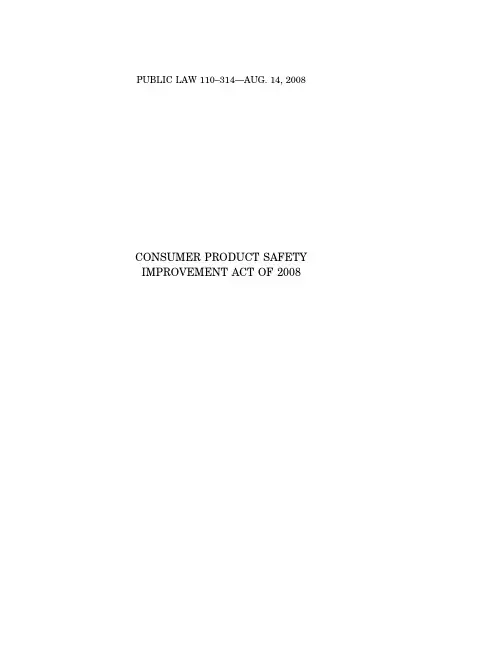
PUBLIC LAW 110–314—AUG. 14, 2008 CONSUMER PRODUCT SAFETY IMPROVEMENT ACT OF 2008122 STAT. 3016 PUBLIC LAW 110–314—AUG. 14, 2008Public Law 110–314110th CongressAn ActTo establish consumer product safety standards and other safety requirements for children’s products and to reauthorize and modernize the Consumer ProductSafety Commission.Be it enacted by the Senate and House of Representatives of the United States of America in Congress assembled, SECTION 1. SHORT TITLE; TABLE OF CONTENTS. (a) S HORT T ITLE .—This Act may be cited as the ‘‘Consumer Product Safety Improvement Act of 2008’’. (b) T ABLE OF C ONTENTS .—The table of contents for this Act is as follows:Sec. 1.Short title; table of contents. Sec. 2.References. Sec. 3.Authority to issue implementing regulations.TITLE I—CHILDREN’S PRODUCT SAFETY Sec.101.Children’s products containing lead; lead paint rule. Sec.102.Mandatory third party testing for certain children’s products. Sec.103.Tracking labels for children’s products. Sec.104.Standards and consumer registration of durable nursery products. beling requirement for advertising toys and games. Sec.106.Mandatory toy safety standards. Sec.107.Study of preventable injuries and deaths in minority children related to consumer products. Sec.108.Prohibition on sale of certain products containing specified phthalates.TITLE II—CONSUMER PRODUCT SAFETY COMMISSION REFORM Subtitle A—Administrative ImprovementsSec.201.Reauthorization of the Commission. Sec.202.Full Commission requirement; interim quorum; personnel. Sec.203.Submission of copy of certain documents to Congress. Sec.204.Expedited rulemaking. Sec.205.Inspector general audits and reports. Sec.206.Industry-sponsored travel ban. Sec.207.Sharing of information with Federal, State, local, and foreign government agencies. Sec.208.Employee training exchanges. Sec.209.Annual reporting requirement.Subtitle B—Enhanced Enforcement AuthoritySec.211.Public disclosure of information. Sec.212.Establishment of a public consumer product safety database. Sec.213.Prohibition on stockpiling under other Commission-enforced statutes. Sec.214.Enhanced recall authority and corrective action plans. Sec.215.Inspection of firewalled conformity assessment bodies; identification of supply chain. Sec.216.Prohibited acts. Sec.217.Penalties. Sec.218.Enforcement by State attorneys general. Sec.219.Whistleblower protections. Consumer Product Safety Improvement Act of 2008. Commerce and trade. 15 USC 2051 note. Aug. 14, 2008[H.R. 4040]122 STAT. 3017 PUBLIC LAW 110–314—AUG. 14, 2008Subtitle C—Specific Import-Export ProvisionsSec.221.Export of recalled and non-conforming products.Sec.222.Import safety management and interagency cooperation.Sec.223.Substantial product hazard list and destruction of noncompliant importedproducts.Sec.224.Financial responsibility.Sec.225.Study and report on effectiveness of authorities relating to safety of im-ported consumer products.Subtitle D—Miscellaneous Provisions and Conforming AmendmentsSec.231.Preemption.Sec.232.All-terrain vehicle standard.Sec.233.Cost-benefit analysis under the Poison Prevention Packaging Act of 1970.Sec.234.Study on use of formaldehyde in manufacturing of textile and apparel ar-ticles.Sec.235.Technical and conforming changes.Sec.236.Expedited judicial review.Sec.237.Repeal.Sec.238.Pool and Spa Safety Act technical amendments.Sec.239.Effective dates and Severability.SEC. 2. REFERENCES.(a) D EFINED T ERMS.—As used in this Act—(1) the term ‘‘appropriate Congressional committees’’ meansthe Committee on Energy and Commerce of the House of Rep-resentatives and the Committee on Commerce, Science, andTransportation of the Senate; and(2) the term ‘‘Commission’’ means the Consumer ProductSafety Commission.(b) C ONSUMER P RODUCT S AFETY A CT.—Except as otherwiseexpressly provided, whenever in this Act an amendment isexpressed as an amendment to a section or other provision, thereference shall be considered to be made to a section or otherprovision of the Consumer Product Safety Act (15 U.S.C. 2051et seq.).SEC. 3. AUTHORITY TO ISSUE IMPLEMENTING REGULATIONS.The Commission may issue regulations, as necessary, to imple-ment this Act and the amendments made by this Act.TITLE I—CHILDREN’S PRODUCT SAFETYSEC. 101. CHILDREN’S P RODUCTS CONTAINING LEAD; LEAD P AINTRULE.(a) G ENERAL L EAD B AN.—(1) T REATMENT AS A BANNED HAZARDOUS SUBSTANCE.—Except as expressly provided in subsection (b) beginning onthe dates provided in paragraph (2), any children’s product(as defined in section 3(a)(16) of the Consumer Product SafetyAct (15 U.S.C. 2052(a)(16))) that contains more lead than thelimit established by paragraph (2) shall be treated as a bannedhazardous substance under the Federal Hazardous SubstancesAct (15 U.S.C. 1261 et seq.).(2) L EAD LIMIT.—(A) 600 PARTS PER MILLION.—Except as provided in subparagraphs (B), (C), (D), and (E), beginning 180 days after the date of enactment of this Act, the lead limit referred to in paragraph (1) is 600 parts per million total lead content by weight for any part of the product.(B) 300 PARTS PER MILLION.—Except as provided by subparagraphs (C), (D), and (E), beginning on the date Effective dates.15 USC 1278a.15 USC 2051 note.15 USC 2051 note.122 STAT. 3018 PUBLIC LAW 110–314—AUG. 14, 2008that is 1 year after the date of enactment of this Act,the lead limit referred to in paragraph (1) is 300 partsper million total lead content by weight for any part ofthe product.(C) 100 PARTS PER MILLION.—Except as provided in Applicability.subparagraphs (D) and (E), beginning on the date thatis 3 years after the date of enactment of this Act, subpara-graph (B) shall be applied by substituting ‘‘100 parts permillion’’ for ‘‘300 parts per million’’ unless the Commissiondetermines that a limit of 100 parts per million is nottechnologically feasible for a product or product category.The Commission may make such a determination onlyafter notice and a hearing and after analyzing the publichealth protections associated with substantially reducinglead in children’s products.(D) A LTERNATE REDUCTION OF LIMIT.—If the Commis-sion determines under subparagraph (C) that the 100 partsper million limit is not technologically feasible for a productor product category, the Commission shall, by regulation,establish an amount that is the lowest amount of lead,lower than 300 parts per million, the Commission deter-mines to be technologically feasible to achieve for thatproduct or product category. The amount of lead establishedby the Commission under the preceding sentence shallbe substituted for the 300 parts per million limit undersubparagraph (B) beginning on the date that is 3 yearsafter the date of enactment of this Act.(E) P ERIODIC REVIEW AND FURTHER REDUCTIONS.—TheCommission shall, based on the best available scientificand technical information, periodically review and revisedownward the limit set forth in this subsection, no lessfrequently than every 5 years after promulgation of thelimit under subparagraph (C) or (D) to require the lowestamount of lead that the Commission determines is techno-logically feasible to achieve. The amount of lead establishedby the Commission under the preceding sentence shallbe substituted for the lead limit in effect immediately beforesuch revision.(b) E XCLUSION OF C ERTAIN M ATERIALS OR P RODUCTS ANDI NACCESSIBLE C OMPONENT P ARTS.—(1) C ERTAIN PRODUCTS OR MATERIALS.—The Commissionmay, by regulation, exclude a specific product or material fromthe prohibition in subsection (a) if the Commission, after noticeand a hearing, determines on the basis of the best-available,objective, peer-reviewed, scientific evidence that lead in suchproduct or material will neither—(A) result in the absorption of any lead into the humanbody, taking into account normal and reasonably foresee-able use and abuse of such product by a child, includingswallowing, mouthing, breaking, or other children’s activi-ties, and the aging of the product; nor(B) have any other adverse impact on public healthor safety.(2) E XCEPTION FOR INACCESSIBLE COMPONENT PARTS.—(A) I N GENERAL.—The limits established under sub-section (a) shall not apply to any component part of achildren’s product that is not accessible to a child through122 STAT. 3019 PUBLIC LAW 110–314—AUG. 14, 2008normal and reasonably foreseeable use and abuse of suchproduct, as determined by the Commission. A componentpart is not accessible under this subparagraph if suchcomponent part is not physically exposed by reason ofa sealed covering or casing and does not become physicallyexposed through reasonably foreseeable use and abuse ofthe product. Reasonably foreseeable use and abuse shallinclude to, swallowing, mouthing, breaking, or other chil-dren’s activities, and the aging of the product.(B) I NACCESSIBILITY PROCEEDING.—Within 1 year afterthe date of enactment of this Act, the Commission shallpromulgate a rule providing guidance with respect to whatproduct components, or classes of components, will beconsidered to be inaccessible for purposes of subparagraph(A).(C) A PPLICATION PENDING CPSC GUIDANCE.—Until theCommission promulgates a rule pursuant to subparagraph(B), the determination of whether a product componentis inaccessible to a child shall be made in accordance withthe requirements laid out in subparagraph (A) for consid-ering a component to be inaccessible to a child.(3) C ERTAIN BARRIERS DISQUALIFIED.—For purposes of thissubsection, paint, coatings, or electroplating may not be consid-ered to be a barrier that would render lead in the substrateinaccessible to a child, or to prevent absorption of any leadinto the human body, through normal and reasonably foresee-able use and abuse of the product.(4) C ERTAIN ELECTRONIC DEVICES.—If the Commissiondetermines that it is not technologically feasible for certainelectronic devices, including devices containing batteries, tocomply with subsection (a), the Commission, by regulation,shall—(A) issue requirements to eliminate or minimize thepotential for exposure to and accessibility of lead in suchelectronic devices, which may include requirements thatsuch electronic devices be equipped with a child-resistantcover or casing that prevents exposure to and accessibilityof the parts of the product containing lead; and(B) establish a schedule by which such electronicdevices shall be in full compliance with the limits in sub-section (a), unless the Commission determines that fullcompliance will not be technologically feasible for suchdevices within a schedule set by the Commission.(5) P ERIODIC REVIEW.—The Commission shall, based onthe best available scientific and technical information, periodi-cally review and revise the regulations promulgated pursuant to this subsection no less frequently than every 5 years after the first promulgation of a regulation under this subsection to make them more stringent and to require the lowest amount of lead the Commission determines is technologically feasible to achieve.(c) A PPLICATION W ITH ASTM F963.—To the extent that any regulation promulgated by the Commission under this section (or any section of the Consumer Product Safety Act or any other Act enforced by the Commission, as such Acts are affected by this section) is inconsistent with the ASTM F963 standard, such Deadline. Requirements. Deadline.122 STAT. 3020 PUBLIC LAW 110–314—AUG. 14, 2008 promulgated regulation shall supersede the ASTM F963 standard to the extent of the inconsistency. (d) T ECHNOLOGICAL F EASIBILITY D EFINED .—For purposes of this section, a limit shall be deemed technologically feasible with regard to a product or product category if— (1) a product that complies with the limit is commercially available in the product category; (2) technology to comply with the limit is commercially available to manufacturers or is otherwise available within the common meaning of the term; (3) industrial strategies or devices have been developed that are capable or will be capable of achieving such a limit by the effective date of the limit and that companies, acting in good faith, are generally capable of adopting; or (4) alternative practices, best practices, or other operational changes would allow the manufacturer to comply with the limit. (e) P ENDING R ULEMAKING P ROCEEDINGS T O H AVE N O E FFECT .— The pendency of a rulemaking proceeding to consider— (1) a delay in the effective date of a limit or an alternate limit under this section related to technological feasibility, (2) an exception for certain products or materials or inacces-sibility guidance under subsection (b) of this section, or (3) any other request for modification of or exemption from any regulation, rule, standard, or ban under this Act or any other Act enforced by the Commission, shall not delay the effect of any provision or limit under this section nor shall it stay general enforcement of the requirements of this section. (f) M ORE S TRINGENT L EAD P AINT B AN .— (1) I N GENERAL .—Effective on the date that is 1 year after the date of enactment of this Act, the Commission shall modify section 1303.1 of its regulations (16 C.F.R. 1301.1) by sub-stituting ‘‘0.009 percent’’ for ‘‘0.06 percent’’ in subsection (a) of that section. (2) P ERIODIC REVIEW AND REDUCTION .—The Commissionshall, no less frequently than every 5 years after the date on which the Commission modifies the regulations pursuant to paragraph (1), review the limit for lead in paint set forth in section 1303.1 of title 16, Code of Federal Regulations (as revised by paragraph (1)), and shall by regulation revise down-ward the limit to require the lowest amount of lead that the Commission determines is technologically feasible to achieve. (3) M ETHODS FOR SCREENING LEAD IN SMALL PAINTED AREAS .—In order to provide for effective and efficient enforce-ment of the limit set forth in section 1303.1 of title 16, Code of Federal Regulations, the Commission may rely on x-ray fluorescence technology or other alternative methods for meas-uring lead in paint or other surface coatings on products subject to such section where the total weight of such paint or surface coating is no greater than 10 milligrams or where such paint or surface coating covers no more than 1 square centimeter of the surface area of such products. Such alternative methods for measurement shall not permit more than 2 micrograms of lead in a total weight of 10 milligrams or less of paint or other surface coating or in a surface area of 1 square centi-meter or less.Deadline. Effective date.122 STAT. 3021 PUBLIC LAW 110–314—AUG. 14, 2008(4) A LTERNATIVE METHODS OF MEASURING LEAD IN PAINT GENERALLY.—(A) S TUDY.—Not later than 1 year after the date ofenactment of this Act, the Commission shall complete astudy to evaluate the effectiveness, precision, and reliabilityof x-ray fluorescence technology and other alternativemethods for measuring lead in paint or other surfacecoatings when used on a children’s product or furniturearticle in order to determine compliance with part 1303of title 16, Code of Federal Regulations, as modified pursu-ant to this subsection.(B) R ULEMAKING.—If the Commission determines,based on the study in subparagraph (A), that x-ray fluores-cence technology or other alternative methods for meas-uring lead in paint are as effective, precise, and reliableas the methodology used by the Commission for compliancedeterminations prior to the date of enactment of this Act,the Commission may promulgate regulations governing theuse of such methods in determining the compliance ofproducts with part 1303 of title 16, Code of Federal Regula-tions, as modified pursuant to this subsection. Any regula-tions promulgated by the Commission shall ensure thatsuch alternative methods are no less effective, precise, andreliable than the methodology used by the Commissionprior to the date of enactment of this Act.(5) P ERIODIC REVIEW.—The Commission shall, no less fre-quently than every 5 years after the Commission completes the study required by paragraph (4)(A), review and revise any methods for measurement utilized by the Commission pursuant to paragraph (3) or pursuant to any regulations promulgated under paragraph (4) to ensure that such methods are the most effective methods available to protect children’s health. The Commission shall conduct an ongoing effort to study and encourage the further development of alternative methods for measuring lead in paint and other surface coating that can effectively, precisely, and reliably detect lead levels at or below the level set forth in part 1303 of title 16, Code of Federal Regulations, or any lower level established by regulation.(6) N O EFFECT ON LEGAL LIMIT.—Nothing in paragraph(3), nor reliance by the Commission on any alternative methodof measurement pursuant to such paragraph, nor any rule prescribed pursuant to paragraph (4), nor any method estab-lished pursuant to paragraph (5) shall be construed to alter the limit set forth in section 1303 of title 16, Code of Federal Regulations, as modified pursuant to this subsection, or provide any exemption from such limit.(7) C ONSTRUCTION.—Nothing in this subsection shall beconstrued to affect the authority of the Commission or any other person to use alternative methods for detecting lead asa screening method to determine whether further testing oraction is needed.(g) T REATMENT AS A R EGULATION U NDER THE FHSA.—Any ban imposed by subsection (a) or rule promulgated under subsection (a) or (b) of this section, and section 1303.1 of title 16, Code of Federal Regulations (as modified pursuant to subsection (f)(1) or (2)), or any successor regulation, shall be considered a regulation of the Commission promulgated under or for the enforcement of Deadline. Deadline.122 STAT. 3022 PUBLIC LAW 110–314—AUG. 14, 2008 section 2(q) of the Federal Hazardous Substances Act (15 U.S.C. 1261(q)). SEC. 102. MANDATORY THIRD P ARTY TESTING FOR CERTAIN CHIL-DREN’S PRODUCTS. (a) M ANDATORY AND T HIRD P ARTY T ESTING .— (1) G ENERAL CONFORMITY CERTIFICATION .— (A) A MENDMENT .—Paragraph (1) of section 14(a) (15 U.S.C. 2063(a)) is amended to read as follows: ‘‘(1) G ENERAL CONFORMITY CERTIFICATION .—Except as pro-vided in paragraphs (2) and (3), every manufacturer of a product which is subject to a consumer product safety rule under this Act or similar rule, ban, standard, or regulation under any other Act enforced by the Commission and which is imported for consumption or warehousing or distributed in commerce (and the private labeler of such product if such product bears a private label) shall issue a certificate which— ‘‘(A) shall certify, based on a test of each product or upon a reasonable testing program, that such product com-plies with all rules, bans, standards, or regulations applicable to the product under this Act or any other Act enforced by the Commission; and ‘‘(B) shall specify each such rule, ban, standard, or regulation applicable to the product.’’. (B) E FFECTIVE DATE .—The amendment made by subparagraph (A) shall take effect 90 days after the date of enactment of this Act. (2) T HIRD PARTY TESTING REQUIREMENT .—Section 14(2) (15 U.S.C. 2063(2)) is further amended by redesignating paragraph (2) as paragraph (4) and inserting after paragraph (1) the following: ‘‘(2) T HIRD PARTY TESTING REQUIREMENT .—Effective on the dates provided in paragraph (3), before importing for consump-tion or warehousing or distributing in commerce any children’s product that is subject to a children’s product safety rule, every manufacturer of such children’s product (and the private labeler of such children’s product if such children’s product bears a private label) shall— ‘‘(A) submit sufficient samples of the children’s product, or samples that are identical in all material respects to the product, to a third party conformity assessment body accredited under paragraph (3) to be tested for compliance with such children’s product safety rule; and ‘‘(B) based on such testing, issue a certificate that certifies that such children’s product complies with the children’s product safety rule based on the assessment of a third party conformity assessment body accredited to conduct such tests. A manufacturer or private labeler shall issue either a separate certificate for each children’s product safety rule applicable to a product or a combined certificate that certifies compliance with all applicable children’s product safety rules, in which case each such rule shall be specified. ‘‘(3) S CHEDULE FOR IMPLEMENTATION OF THIRD PARTY TESTING .— ‘‘(A) G ENERAL APPLICATION .—Except as provided under subparagraph (F), the requirements of paragraph (2) shallNotice. Certification.15 USC 2063 note.122 STAT. 3023 PUBLIC LAW 110–314—AUG. 14, 2008apply to any children’s product manufactured more than90 days after the Commission has established and pub-lished notice of the requirements for accreditation of thirdparty conformity assessment bodies to assess conformitywith a children’s product safety rule to which such chil-dren’s product is subject.‘‘(B) T IME LINE FOR ACCREDITATION.—‘‘(i) L EAD PAINT.—Not later than 30 days after the date of enactment of the Consumer Product Safety Improvement Act of 2008, the Commission shall pub-lish notice of the requirements for accreditation of third party conformity assessment bodies to assess con-formity with part 1303 of title 16, Code of Federal Regulations.‘‘(ii) F ULL-SIZE CRIBS; NON FULL-SIZE CRIBS; PAC-IFIERS.—Not later than 60 days after the date of enact-ment of the Consumer Product Safety Improvement Act of 2008, the Commission shall publish notice of the requirements for accreditation of third party con-formity assessment bodies to assess conformity with parts 1508, 1509, and 1511 of such title.‘‘(iii) S MALL PARTS.—Not later than 90 days after the date of enactment of the Consumer Product Safety Improvement Act of 2008, the Commission shall pub-lish notice of the requirements for accreditation of third party conformity assessment bodies to assess con-formity with part 1501 of such title.‘‘(iv) C HILDREN’S METAL JEWELRY.—Not later than 120 days after the date of enactment of the Consumer Product Safety Improvement Act of 2008, the Commis-sion shall publish notice of the requirements for accreditation of third party conformity assessment bodies to assess conformity with the requirements of section 101(a)(2) of such Act with respect to children’s metal jewelry.‘‘(v) B ABY BOUNCERS, WALKERS, AND JUMPERS.— Not later than 210 days after the date of enactment of the Consumer Product Safety Improvement Act of 2008, the Commission shall publish notice of the requirements for accreditation of third party con-formity assessment bodies to assess conformity with parts 1500.18(a)(6) and 1500.86(a) of such title.‘‘(vi) A LL OTHER CHILDREN’S PRODUCT SAFETY RULES.—The Commission shall publish notice of the requirements for accreditation of third party con-formity assessment bodies to assess conformity with other children’s product safety rules at the earliest practicable date, but in no case later than 10 months after the date of enactment of the Consumer Product Safety Improvement Act of 2008, or, in the case of children’s product safety rules established or revised1 year or more after such date of enactment, not laterthan 90 days before such rules or revisions take effect.‘‘(C) A CCREDITATION.—Accreditation of third party con-formity assessment bodies pursuant to the requirements established under subparagraph (B) may be conducted Deadlines. Notices.122 STAT. 3024 PUBLIC LAW 110–314—AUG. 14, 2008 either by the Commission or by an independent accredita-tion organization designated by the Commission. ‘‘(D) P ERIODIC REVIEW .—The Commission shall periodi-cally review and revise the accreditation requirements established under subparagraph (B) to ensure that the requirements assure the highest conformity assessment body quality that is feasible. ‘‘(E) P UBLICATION OF ACCREDITED ENTITIES .—The Commission shall maintain on its Internet website an up- to-date list of entities that have been accredited to assess conformity with children’s product safety rules in accord-ance with the requirements published by the Commission under this paragraph. ‘‘(F) E XTENSION .—If the Commission determines that an insufficient number of third party conformity assess-ment bodies have been accredited to permit certification for a children’s product safety rule under the accelerated schedule required by this paragraph, the Commission may extend the deadline for certification to such rule by not more than 60 days. ‘‘(G) R ULEMAKING .—Until the date that is 3 years after the Consumer Product Safety Improvement Act of 2008, Commission proceedings under this paragraph shall be exempt from the requirements of sections 553 and 601 through 612 of title 5, United States Code.’’. (3) C ONFORMING AMENDMENTS .—Section 14(a)(4) (15 U.S.C. 2063(a)(4)), as redesignated by paragraph (2) of this subsection, is amended— (A) by striking ‘‘required by paragraph (1) of this sub-section’’ and inserting ‘‘required under paragraph (1), (2), or (3)’’; and (B) by striking ‘‘requirement under paragraph (1)’’ and inserting ‘‘requirement under paragraph (1), (2), or (3)’’. (b) A DDITIONAL R EQUIREMENTS ; D EFINITIONS .—Section 14 (15 U.S.C. 2063) is further amended by adding at the end the following: ‘‘(d) A DDITIONAL R EGULATIONS FOR T HIRD P ARTY T ESTING .— ‘‘(1) A UDIT .—Not later than 10 months after the date of enactment of the Consumer Product Safety Improvement Act of 2008, the Commission shall by regulation establish require-ments for the periodic audit of third party conformity assess-ment bodies as a condition for the continuing accreditation of such conformity assessment bodies under subsection (a)(3)(C). ‘‘(2) C OMPLIANCE ; CONTINUING TESTING .—Not later than 15 months after the date of enactment of the Consumer Product Safety Improvement Act of 2008, the Commission shall by regulation— ‘‘(A) initiate a program by which a manufacturer or private labeler may label a consumer product as complying with the certification requirements of subsection (a); and ‘‘(B) establish protocols and standards— ‘‘(i) for ensuring that a children’s product tested for compliance with an applicable children’s product safety rule is subject to testing periodically and when there has been a material change in the product’s design or manufacturing process, including the sourcing of component parts;Protocols. Standards. Deadlines.Termination date.Web site. Records.PUBLIC LAW 110–314—AUG. 14, 2008122 STAT. 3025‘‘(ii) for the testing of random samples to ensurecontinued compliance;‘‘(iii) for verifying that a children’s product testedby a conformity assessment body complies withapplicable children’s product safety rules; and‘‘(iv) for safeguarding against the exercise of undueinfluence on a third party conformity assessment bodyby a manufacturer or private labeler.‘‘(e) W ITHDRAWAL OF A CCREDITATION.—‘‘(1) I N GENERAL.—The Commission may withdraw itsaccreditation or its acceptance of the accreditation of a thirdparty conformity assessment body accredited under this sectionif the Commission finds, after notice and investigation, that—‘‘(A) a manufacturer, private labeler, or governmental entity has exerted undue influence on such conformityassessment body or otherwise interfered with or com-promised the integrity of the testing process with respectto the certification of a children’s product under this sec-tion; or‘‘(B) such conformity assessment body failed to comply with an applicable protocol, standard, or requirement estab-lished by the Commission under subsection (d).‘‘(2) P ROCEDURE.—In any proceeding to withdraw the accreditation of a conformity assessment body, the Commis-sion—‘‘(A) shall consider the gravity of the conformity assess-ment body’s action or failure to act, including—‘‘(i) whether the action or failure to act resultedin injury, death, or the risk of injury or death;‘‘(ii) whether the action or failure to act constitutesan isolated incident or represents a pattern or practice;and‘‘(iii) whether and when the conformity assessmentbody initiated remedial action; and‘‘(B) may—‘‘(i) withdraw its acceptance of the accreditationof the conformity assessment body on a permanentor temporary basis; and‘‘(ii) establish requirements for reaccreditation ofthe conformity assessment body.‘‘(3) F AILURE TO COOPERATE.—The Commission may sus-pend the accreditation of a conformity assessment body if itfails to cooperate with the Commission in an investigationunder this section.‘‘(f) D EFINITIONS.—In this section:‘‘(1) C HILDREN’S PRODUCT SAFETY RULE.—The term ‘chil-dren’s product safety rule’ means a consumer product safetyrule under this Act or similar rule, regulation, standard, orban under any other Act enforced by the Commission, includinga rule declaring a consumer product to be a banned hazardousproduct or substance.‘‘(2) T HIRD PARTY CONFORMITY ASSESSMENT BODY.—‘‘(A) I N GENERAL.—The term ‘third party conformity assessment body’ means a conformity assessment bodythat, except as provided in subparagraph (D), is not owned,managed, or controlled by the manufacturer or private。
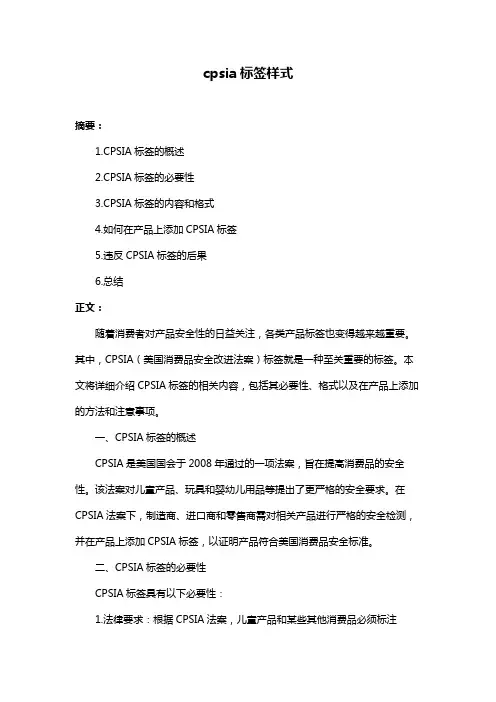
cpsia标签样式摘要:1.CPSIA标签的概述2.CPSIA标签的必要性3.CPSIA标签的内容和格式4.如何在产品上添加CPSIA标签5.违反CPSIA标签的后果6.总结正文:随着消费者对产品安全性的日益关注,各类产品标签也变得越来越重要。
其中,CPSIA(美国消费品安全改进法案)标签就是一种至关重要的标签。
本文将详细介绍CPSIA标签的相关内容,包括其必要性、格式以及在产品上添加的方法和注意事项。
一、CPSIA标签的概述CPSIA是美国国会于2008年通过的一项法案,旨在提高消费品的安全性。
该法案对儿童产品、玩具和婴幼儿用品等提出了更严格的安全要求。
在CPSIA法案下,制造商、进口商和零售商需对相关产品进行严格的安全检测,并在产品上添加CPSIA标签,以证明产品符合美国消费品安全标准。
二、CPSIA标签的必要性CPSIA标签具有以下必要性:1.法律要求:根据CPSIA法案,儿童产品和某些其他消费品必须标注CPSIA标签,否则将面临罚款、召回产品等处罚。
2.消费者权益保障:CPSIA标签有助于消费者了解产品的安全性能和适用年龄,从而确保消费者的权益。
3.市场竞争力:拥有CPSIA标签的产品,更容易获得消费者的信任,提高市场竞争力。
三、CPSIA标签的内容和格式CPSIA标签主要包括以下内容:1.生产商或进口商的名称和联系方式。
2.产品型号和批次号。
3.产品适用的年龄段。
4.符合的美国安全标准。
5.检测机构的名称和认证标志。
CPSIA标签的格式没有统一的要求,但通常包括以上信息,并采用易于阅读的字体和颜色。
四、如何在产品上添加CPSIA标签1.首先,确保产品符合CPSIA法案的相关要求。
2.选择合适的标签材料,如纸质、塑料等。
3.设计标签内容,包括上述提到的必要信息。
4.将标签粘贴在产品或包装的显眼位置。
5.如果产品有多个部件,每个部件上都应添加CPSIA标签。
五、违反CPSIA标签的后果违反CPSIA标签规定,可能会导致以下后果:1.面临罚款:美国消费品安全委员会(CPSC)有权对违反CPSIA法案的企业进行罚款。
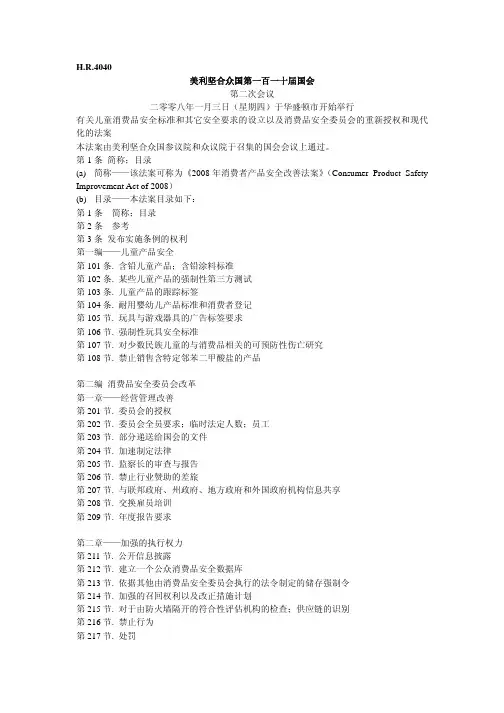
H.R.4040美利坚合众国第一百一十届国会第二次会议二零零八年一月三日(星期四)于华盛顿市开始举行有关儿童消费品安全标准和其它安全要求的设立以及消费品安全委员会的重新授权和现代化的法案本法案由美利坚合众国参议院和众议院于召集的国会会议上通过。
第1条简称;目录(a) 简称——该法案可称为《2008年消费者产品安全改善法案》(Consumer Product Safety Improvement Act of 2008)(b) 目录——本法案目录如下:第1条简称;目录第2条参考第3条发布实施条例的权利第一编——儿童产品安全第101条. 含铅儿童产品;含铅涂料标准第102条. 某些儿童产品的强制性第三方测试第103条. 儿童产品的跟踪标签第104条. 耐用婴幼儿产品标准和消费者登记第105节. 玩具与游戏器具的广告标签要求第106节. 强制性玩具安全标准第107节. 对少数民族儿童的与消费品相关的可预防性伤亡研究第108节. 禁止销售含特定邻苯二甲酸盐的产品第二编消费品安全委员会改革第一章——经营管理改善第201节. 委员会的授权第202节. 委员会全员要求;临时法定人数;员工第203节. 部分递送给国会的文件第204节. 加速制定法律第205节. 监察长的审查与报告第206节. 禁止行业赞助的差旅第207节. 与联邦政府、州政府、地方政府和外国政府机构信息共享第208节. 交换雇员培训第209节. 年度报告要求第二章——加强的执行权力第211节. 公开信息披露第212节. 建立一个公众消费品安全数据库第213节. 依据其他由消费品安全委员会执行的法令制定的储存强制令第214节. 加强的召回权利以及改正措施计划第215节. 对于由防火墙隔开的符合性评估机构的检查;供应链的识别第216节. 禁止行为第217节. 处罚第218节. 由州总检察长执行第219节. 举报人保护第三章——详细的进出口相关规定第221节. 召回品及不合格品的出口第222节. 进口安全管理及跨部门间的合作第223节. 重大产品隐患清单及不合格进口产品的消毁第224节. 财政责任第225节. 与进口消费品安全相关的公权力效力研究及报告第四章——杂项规定及顺应性修订第231节. 先占性第232节. 各类地形用车辆标准第233节. 按照《1970年的危险品包装法案》实施成本效益分析第234节. 织物及服饰产品中的甲醛使用研究第235节. 技术及顺应性变化第236节. 加快复审第237节. 撤消第238节. 浴池及温泉安全技术修订第239节. 生效日期及可分割性第2条参考(a) 本法案中使用的术语定义:(1) “相关国会委员会”指的是众议院能源与商务委员会(Committee on Energy and Commerce of the House of Representatives)和参议院参议院商务、科学和运输委员会(Committee on Commerce, Science, and Transportation of the Senate);(2) 术语“委员会”指的是消费品安全委员会。
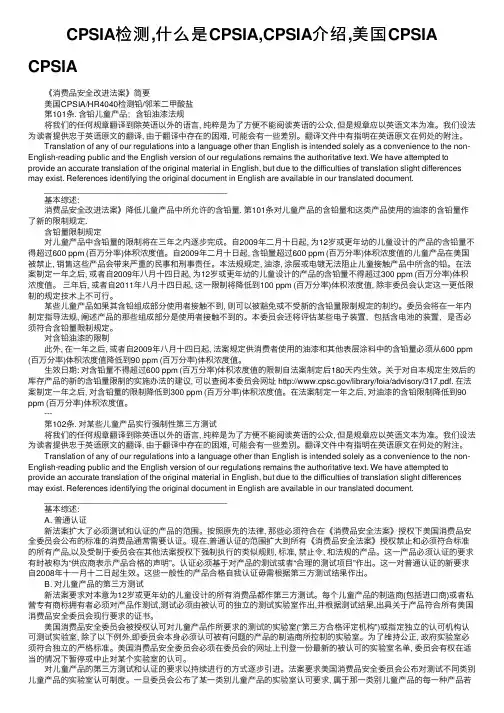
CPSIA检测,什么是CPSIA,CPSIA介绍,美国CPSIA CPSIA 《消费品安全改进法案》简要 美国CPSIA/HR4040检测铅/邻苯⼆甲酸盐 第101条. 含铅⼉童产品;含铅油漆法规 将我们的任何规章翻译到除英语以外的语⾔, 纯粹是为了⽅便不能阅读英语的公众, 但是规章应以英语⽂本为准。
我们设法为读者提供忠于英语原⽂的翻译, 由于翻译中存在的困难, 可能会有⼀些差别。
翻译⽂件中有指明在英语原⽂在何处的附注。
Translation of any of our regulations into a language other than English is intended solely as a convenience to the non-English-reading public and the English version of our regulations remains the authoritative text. We have attempted to provide an accurate translation of the original material in English, but due to the difficulties of translation slight differences may exist. References identifying the original document in English are available in our translated document. ________________________________________ 基本综述: 消费品安全改进法案》降低⼉童产品中所允许的含铅量. 第101条对⼉童产品的含铅量和这类产品使⽤的油漆的含铅量作了新的限制规定. 含铅量限制规定 对⼉童产品中含铅量的限制将在三年之内逐步完成。
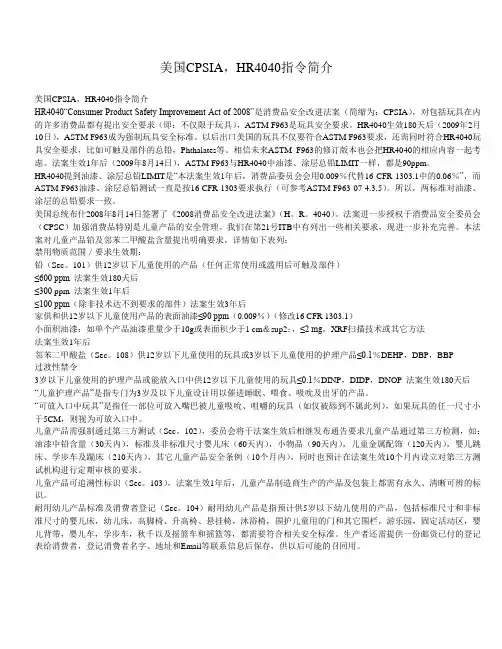
美国CPSIA,HR4040指令简介美国CPSIA,HR4040指令简介HR4040“Consumer Product Safety Improvement Act of 2008”是消费品安全改进法案(简缩为:CPSIA),对包括玩具在内的许多消费品都有提出安全要求(即:不仅限于玩具),ASTM F963是玩具安全要求。
HR4040生效180天后(2009年2月10日),ASTM F963成为强制玩具安全标准。
以后出口美国的玩具不仅要符合ASTM F963要求,还需同时符合HR4040玩具安全要求,比如可触及部件的总铅,Phthalates等。
相信未来ASTM F963的修订版本也会把HR4040的相应内容一起考虑。
法案生效1年后(2009年8月14日),ASTM F963与HR4040中油漆、涂层总铅LIMIT一样,都是90ppm。
HR4040提到油漆、涂层总铅LIMIT是“本法案生效1年后,消费品委员会会用0.009%代替16 CFR 1303.1中的0.06%”,而ASTM F963油漆、涂层总铅测试一直是按16 CFR 1303要求执行(可参考ASTM F963-07 4.3.5)。
所以,两标准对油漆、涂层的总铅要求一致。
美国总统布什2008年8月14日签署了《2008消费品安全改进法案》(H。
R。
4040)。
法案进一步授权于消费品安全委员会(CPSC)加强消费品特别是儿童产品的安全管理。
我们在第21号ITB中有列出一些相关要求,现进一步补充完善。
本法案对儿童产品铅及邻苯二甲酸盐含量提出明确要求,详情如下表列:禁用物质范围/要求生效期:铅(Sec。
101)供12岁以下儿童使用的产品(任何正常使用或滥用后可触及部件)≤600 ppm 法案生效180天后≤300 ppm 法案生效1年后≤100 ppm(除非技术达不到要求的部件)法案生效3年后家俱和供12岁以下儿童使用产品的表面油漆≤90 ppm(0.009%)(修改16 CFR 1303.1)小面积油漆:如单个产品油漆重量少于10g或表面积少于1 cm²,≤2 mg,XRF扫描技术或其它方法法案生效1年后邻苯二甲酸盐(Sec。

儿童化妆品cpc认证标准
CPC认证(儿童产品证书Children's Product Certifi cate)是指根据美国消费品安全改进法案(CPSIA)的要求,生产儿童产品的企业需要向美国消费品安全委员会(CPSC)提供证明,证明其产品符合相关的安全标准。
CPC证书必须随产品一起包装,并在产品上市时提供给零售商和消费者。
儿童化妆品CPC认证的标准主要包括以下几个方面:
1.安全法规:儿童化妆品必须符合美国食品和药物管理局(FDA)对化妆品的安全性要求,以及CPSIA对儿童产品的铅含量和邻苯二甲酸盐(Phthalates)含量限制。
2.标签要求:化妆品包装上需要有清晰的标签,包括产品成分、生产日期、有效期、使用方法、警告和注意事项等。
3.包装安全:化妆品包装应足够坚固,能够保护内容物免受外界污染,且不易被儿童误用,防止造成窒息等危险。
4.产品测试:生产商需要对儿童化妆品进行第三方测试,确保产品符合上述的安全标准和法规要求。
5.合规声明:CPC证书中需要包含生产商对产品合规性的声明。
要注意的是,上述标准可能会随着法规的更新而变化,因此生产商需要持续关注相关法规的最新动态,并确保产品的合规性。
在中国出口儿童化妆品到美国市场时,除了要满足中国的相关法规外,还需要确保产品符合美国的法规要求。
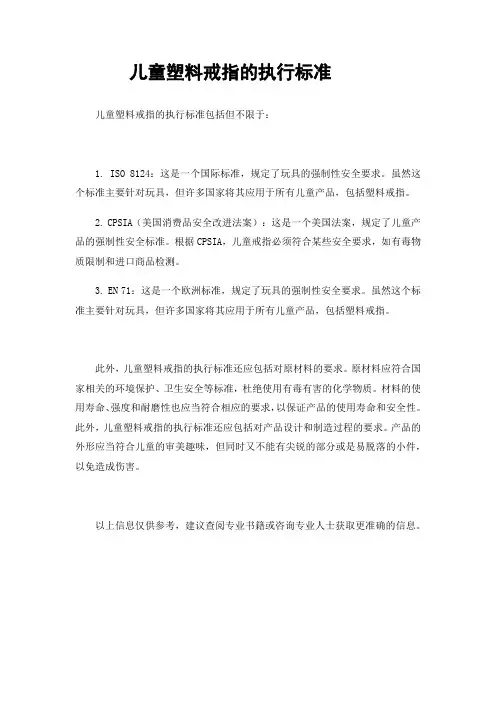
儿童塑料戒指的执行标准
儿童塑料戒指的执行标准包括但不限于:
1. ISO 8124:这是一个国际标准,规定了玩具的强制性安全要求。
虽然这个标准主要针对玩具,但许多国家将其应用于所有儿童产品,包括塑料戒指。
2. CPSIA(美国消费品安全改进法案):这是一个美国法案,规定了儿童产品的强制性安全标准。
根据CPSIA,儿童戒指必须符合某些安全要求,如有毒物质限制和进口商品检测。
3. EN 71:这是一个欧洲标准,规定了玩具的强制性安全要求。
虽然这个标准主要针对玩具,但许多国家将其应用于所有儿童产品,包括塑料戒指。
此外,儿童塑料戒指的执行标准还应包括对原材料的要求。
原材料应符合国家相关的环境保护、卫生安全等标准,杜绝使用有毒有害的化学物质。
材料的使用寿命、强度和耐磨性也应当符合相应的要求,以保证产品的使用寿命和安全性。
此外,儿童塑料戒指的执行标准还应包括对产品设计和制造过程的要求。
产品的外形应当符合儿童的审美趣味,但同时又不能有尖锐的部分或是易脱落的小件,以免造成伤害。
以上信息仅供参考,建议查阅专业书籍或咨询专业人士获取更准确的信息。
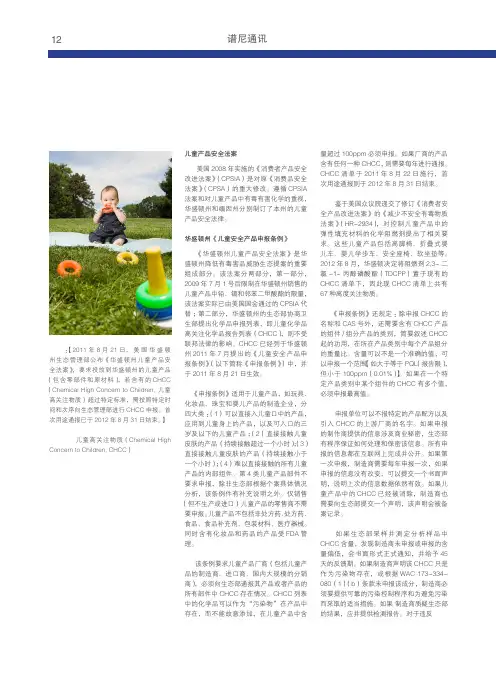
谱尼通讯12摘要:【2011年8月21日,美国华盛顿州生态管理部公布《华盛顿州儿童产品安全法案》,要求投放到华盛顿州的儿童产品(包含零部件和原材料),若含有的CHCC (Chemical High Concern to Children, 儿童高关注物质)超过特定标准,需按照特定时间和次序向生态管理部进行CHCC 申报。
首次用途通报已于2012年8月31日结束。
】关键词:儿童高关注物质(Chemical High Concern to Children, CHCC)美国华盛顿州和缅因州儿童产品中高关注化学品CHCC简介儿童产品安全法案美国2008年实施的《消费者产品安全改进法案》(CPSIA)是对原《消费品安全法案》(CPSA)的重大修改。
遵循CPSIA 法案和对儿童产品中有毒有害化学的重视,华盛顿州和缅因州分别制订了本州的儿童产品安全法律。
华盛顿州《儿童安全产品申报条例》 《华盛顿州儿童产品安全法案》是华盛顿州降低有毒害品威胁生态提案的重要组成部分。
该法案分两部分,第一部分,2009年7月1号后限制在华盛顿州销售的儿童产品中铅、镉和邻苯二甲酸酯的限量,该法案实际已由美国国会通过的CPSIA 代替;第二部分,华盛顿州的生态部协商卫生部提出化学品申报列表,即儿童化学品高关注化学品报告列表(CHCC),则不受联邦法律的影响。
CHCC 已经列于华盛顿州2011年7月提出的《儿童安全产品申报条例》(以下简称《申报条例》)中,并于2011年8月21日生效。
《申报条例》适用于儿童产品,如玩具、化妆品、珠宝和婴儿产品的制造企业,分四大类:(1)可以直接入儿童口中的产品,应用到儿童身上的产品,以及可入口的三岁及以下的儿童产品;(2)直接接触儿童皮肤的产品(持续接触超过一个小时);(3)直接接触儿童皮肤的产品(持续接触小于一个小时);(4)难以直接接触的所有儿童产品的内部组件。
第4类儿童产品部件不要求申报,除非生态部根据个案具体情况分析,该条例件有补充说明之外。
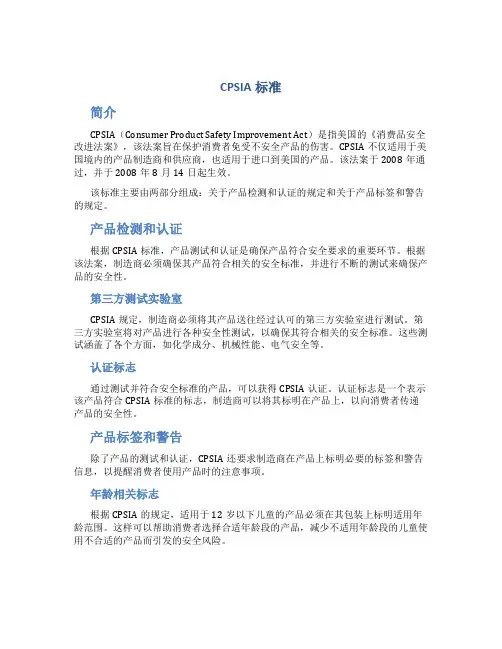
CPSIA标准简介CPSIA(Consumer Product Safety Improvement Act)是指美国的《消费品安全改进法案》,该法案旨在保护消费者免受不安全产品的伤害。
CPSIA不仅适用于美国境内的产品制造商和供应商,也适用于进口到美国的产品。
该法案于2008年通过,并于2008年8月14日起生效。
该标准主要由两部分组成:关于产品检测和认证的规定和关于产品标签和警告的规定。
产品检测和认证根据CPSIA标准,产品测试和认证是确保产品符合安全要求的重要环节。
根据该法案,制造商必须确保其产品符合相关的安全标准,并进行不断的测试来确保产品的安全性。
第三方测试实验室CPSIA规定,制造商必须将其产品送往经过认可的第三方实验室进行测试。
第三方实验室将对产品进行各种安全性测试,以确保其符合相关的安全标准。
这些测试涵盖了各个方面,如化学成分、机械性能、电气安全等。
认证标志通过测试并符合安全标准的产品,可以获得CPSIA认证。
认证标志是一个表示该产品符合CPSIA标准的标志,制造商可以将其标明在产品上,以向消费者传递产品的安全性。
产品标签和警告除了产品的测试和认证,CPSIA还要求制造商在产品上标明必要的标签和警告信息,以提醒消费者使用产品时的注意事项。
年龄相关标志根据CPSIA的规定,适用于12岁以下儿童的产品必须在其包装上标明适用年龄范围。
这样可以帮助消费者选择合适年龄段的产品,减少不适用年龄段的儿童使用不合适的产品而引发的安全风险。
警告标签一些产品可能会存在一定的安全风险,制造商必须标明警告标签来提醒消费者。
这些警告标签可能包括但不限于:窒息危险、电气危险、化学品危险等。
警告标签应清晰明了,能够明确传递给消费者相关的安全风险信息。
CPSIA的重要性CPSIA标准的实施对于产品制造商和供应商来说非常重要,它有以下几个方面的重要性:保护消费者CPSIA标准的制定目的是为了保护消费者免受不安全产品的伤害。
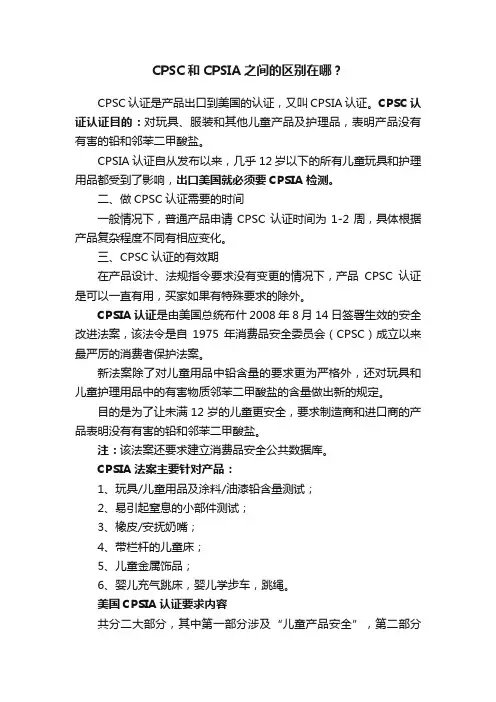
CPSC和CPSIA之间的区别在哪?CPSC认证是产品出口到美国的认证,又叫CPSIA认证。
CPSC认证认证目的:对玩具、服装和其他儿童产品及护理品,表明产品没有有害的铅和邻苯二甲酸盐。
CPSIA认证自从发布以来,几乎12岁以下的所有儿童玩具和护理用品都受到了影响,出口美国就必须要CPSIA检测。
二、做CPSC认证需要的时间一般情况下,普通产品申请CPSC认证时间为1-2周,具体根据产品复杂程度不同有相应变化。
三、CPSC认证的有效期在产品设计、法规指令要求没有变更的情况下,产品CPSC认证是可以一直有用,买家如果有特殊要求的除外。
CPSIA认证是由美国总统布什2008年8月14日签署生效的安全改进法案,该法令是自1975年消费品安全委员会(CPSC)成立以来最严厉的消费者保护法案。
新法案除了对儿童用品中铅含量的要求更为严格外,还对玩具和儿童护理用品中的有害物质邻苯二甲酸盐的含量做出新的规定。
目的是为了让未满12岁的儿童更安全,要求制造商和进口商的产品表明没有有害的铅和邻苯二甲酸盐。
注:该法案还要求建立消费品安全公共数据库。
CPSIA法案主要针对产品:1、玩具/儿童用品及涂料/油漆铅含量测试;2、易引起窒息的小部件测试;3、橡皮/安抚奶嘴;4、带栏杆的儿童床;5、儿童金属饰品;6、婴儿充气跳床,婴儿学步车,跳绳。
美国CPSIA认证要求内容共分二大部分,其中第一部分涉及“儿童产品安全”,第二部分涉及“消费品安全委员会改革”,其中第一部分内容涉及的章节如下:第101条. 含铅儿童产品;含铅涂料标准第102条. 某些儿童产品的强制性第三方测试第103条. 儿童产品的跟踪标签第104条. 耐用婴幼儿产品标准和消费者登记第105节. 玩具与游戏器具的广告标签要求第106节. 强制性玩具安全标准第107节. 对少数民族儿童的与消费品相关的可预防性伤亡研究第108节. 禁止销售含特定邻苯二甲酸盐的产品CPSIA法案扩大了需要进行测试和认证的产品范围。
一、名词:1、CPSIA:The C onsumer P roduct S afetyI mprovement A ct中文翻译:消费品安全改进法案2、CPSC:C onsumer P roduct S afetyC ommission消费品安全协会(美国)二、法案简述:1、美国总统布什于2008年8 月14 日正式签署生效消费品安全改进法案(CPSIA/HR4040),成为法律。
该法令是自1972年消费品安全委员会(CPSC)成立以来最严厉的消费者保护法案;2、新法案除了对儿童产品中铅含量的要求更为严格外,还对玩具和儿童护理用品中的有害物质邻苯二甲酸盐的含量做出新的规定。
此外,该法案还要求建立消费品安全公共数据库;3、CPSIA 影响着美国所有生产、进口、分销玩具、服装和其他儿童产品及护理品的相关行业。
所有制造商应该保证其产品符合该法案的所有规定、禁令、标准或者规则,在邻苯二甲酸盐含量中,除了DINP、DIDP及DNOP暂时被禁止使用,直到慢性病危害专家组研究报告出台后再决定是否解禁或列为永久禁止使用外,DEHP、DBP及BBP已被永久禁止使用;4、现在,所有相关产品在进入美国市场以前,必须通过美国消费品安全委员会CPSC 认可检测机构检测,否则将面对巨额罚款并导致出口中断。
5、CPSC玩具检测项目包括(不限于):* 儿童玩具、儿童护理品及涂料/油漆铅含量测试* 易引起窒息的小部件测试* 橡皮/安抚奶嘴* ......*儿童玩具:指给12岁以下儿设计的,在儿童玩耍时使用的消费品;*儿童护理品:指给3岁以下儿设计的,为哄孩子入睡或喂食,帮助儿童吸奶或磨牙使用的消费品。
三、法规生效时间:2008年8月14日四、法规管控的有害物质:1、产品中的铅(法案中没说清楚,一般理解为含铅涂料);2、6P(DEHP、DBP、BBP、DINP、DIDP和DNOP)五、有害物质限量值:1、儿童产品中的铅:A、600PPM:本法案颁布180天后(2009/2/10);B、300PPM:本法案颁布1年后(2009/8/14);C、100PPM:本法案颁布3年后(2011/8/14);除非委员会认定技术上不可行。
《消费品安全改进法案》(CPSIA)常见问题与解答1 第101(f)(3)节关于含铅油漆测试以及小面积部分是否可以免测?答:新法律并未对涂漆的小面积部分就适用的含铅限制标准给予豁免。
对于油漆或表层涂料总重量不超过10毫克或油漆或表层涂料面积不超过1平方厘米的产品,法律的确允许委员会采用X射线荧光技术(XRF)或其他替代方法进行筛选检验。
使用这种替代检验方法时,油漆或表层涂料总重量不超过10毫克或面积不超过1平方厘米的产品中的含铅量不得超过2微克。
2 根据美国联邦法规16 CFR § 1303.2,对含铅油漆和类似表层涂料的禁令并未包括电镀,新法案是否也如此规定?经电镀的底层是否可被视为“不可能被接触”?答:对于含铅的儿童产品,CPSIA具体规定油漆、涂层或电镀不得被视为可使底层中的铅不会被孩子接触的隔离层。
因此,电镀过的底层并不构成可受某儿童产品对CPSIA中有关含铅量限制标准豁免的基础。
根据16 CFR part 1303实施监管的物品,包括油漆和某些油漆过的物品,油漆和其他类似表层涂料的定义与过去相同,仍然不包括电镀。
3 关于儿童产品中总含铅量的新规定是否也适用于儿童书籍、磁带和CD、印刷的游戏板、招贴以及用于儿童教育的其他印刷品?答: 是的。
CPSIA对儿童产品的定义是主要为不超过12岁的儿童使用的产品。
因此这些产品必须符合美国联邦法规16 CFR part 1303关于油漆和表层涂料的含铅限制标准,以及于2009年8月14日生效的90ppm含铅量标准,另外还须符合关于儿童产品含铅量的新标准,如果儿童产品使用的印刷油墨或材料实际上成了底层的一部分,(例如塑料颗粒中的颜色)或是通过电镀或瓷釉与底层粘合的材料,就毋需执行含铅油漆限制标准。
但是,无论是否被排除在含铅限制标准之外,这些产品仍将被视作含铅产品,因此仍须符合儿童产品含铅量限制标准。
对于含铅儿童产品CPSIA有具体规定,油漆、涂层或电镀层不得被视为防止孩子接触到的底层中的铅的隔离层。
CPSIA标签样式1. 什么是CPSIA标签?CPSIA(Consumer Product Safety Improvement Act)是美国的一项消费品安全法案,于2008年通过并于2009年生效。
该法案旨在保护消费者免受不安全产品的伤害,特别是儿童产品。
CPSIA要求所有销售到美国市场的儿童产品都必须符合一系列的安全标准,并且需要在产品上附加CPSIA标签。
CPSIA标签是一种特殊的标签,用于识别符合CPSIA安全标准的产品。
它通常包含了一些重要信息,如制造商的名称、地址、生产日期、产品批次号等。
这些信息旨在提供给消费者和监管机构,以确保产品的追溯性和安全性。
2. CPSIA标签样式要求CPSIA标签的样式要求在CPSIA法案中有明确规定。
以下是一些常见的CPSIA标签样式要求:2.1 标签尺寸和材质CPSIA标签的尺寸应足够大,以便消费者可以清晰地阅读上面的信息。
一般来说,标签的尺寸应不小于1英寸(2.54厘米)x 1英寸(2.54厘米)。
标签的材质应耐久且易于清洗,以确保标签的可读性。
常见的材质包括布料、纸张和塑料。
2.2 标签颜色和文字CPSIA标签的背景颜色应与产品的颜色形成鲜明对比,以确保信息的可读性。
常见的背景颜色包括白色、浅黄色和浅蓝色。
标签上的文字应使用黑色或其他深色字体,以确保文字清晰可见。
字体的大小应适中,不要过小或过大。
常见的字体包括Arial、Times New Roman等。
2.3 标签内容CPSIA标签的内容应包括以下信息:•制造商的名称或注册商标•制造商的地址或联系方式•产品的生产日期或批次号•产品的材质成分•产品的警示信息(如适用)这些信息应以清晰易读的方式呈现,以便消费者和监管机构可以轻松获取。
2.4 标签附着方式CPSIA标签应牢固地附着在产品上,以防止意外脱落。
常见的附着方式包括缝制、热封或使用特殊的胶粘剂。
3. 如何设计CPSIA标签样式?设计CPSIA标签样式时,需要考虑以下几个方面:3.1 品牌一致性CPSIA标签是产品的一部分,因此应与产品的整体品牌风格保持一致。
CPSIA总铅含量豁免情况解释CPSIA(Consumer Product Safety Improvement Act)是美国颁布的一项消费品安全法案,旨在保护儿童免受含铅产品的危害。
根据CPSIA,所有在美国销售的儿童产品必须符合严格的铅含量限制。
然而,CPSIA也为一些特定情况下的产品提供了铅含量豁免,本文将对这些豁免情况进行解释。
首先,CPSIA对一些原材料存在铅含量豁免。
这些原材料包括铅晶体、铅玻璃、成人服装和饰品以及一些特定的金属合金等。
由于这些原材料在制造过程中难以完全去除铅元素,CPSIA对其铅含量设置了一定的限制,使得这些产品仍然能够合法销售。
其次,CPSIA还针对一些特定用途的产品提供了铅含量豁免。
例如,医疗器械、计算机和电子设备中的一些组件以及交通工具中的一些部件,由于其特殊的用途和制造过程,无法彻底排除铅元素。
因此,CPSIA对这些产品的铅含量也设置了一定的限制,以保证其使用安全性。
此外,CPSIA还对一些艺术或古董类产品提供了铅含量豁免。
这类产品通常是以古董或艺术品的形式存在,而非作为儿童玩具。
在这些产品中,铅元素通常是由于年代久远、制造工艺特殊或其中一种特殊材质的缘故而存在。
虽然这些产品无法去除铅元素,但由于其用途和设计,不会对儿童构成危险。
最后,CPSIA还允许通过豁免程序获得特殊产品的铅含量豁免。
豁免程序是指利益相关者在向美国消费品安全委员会(CPSC)提交申请后进行的一系列审查和评估流程。
如果该产品的缺乏合理替代品,并且豁免对公众利益和儿童安全没有直接或间接的不利影响,那么可以获得豁免。
需要注意的是,即使产品符合铅含量豁免要求,其制造商仍然需要提供明显的标识以告知消费者。
这有助于消费者识别豁免产品,从而能够作出决策,确保自己和自己的孩子的安全。
总的来说,CPSIA总铅含量豁免是针对一些特定情况下的产品,经过严格审查和评估后,可以在合法销售中免除一定的铅含量限制。
订阅更多信息,请登录我们的网站注册:/about/subscibe.aspx 。
CN-166 / Nov 2008美国消费品安全改进法(CPSIA)最新消息美国消费品安全委员会(CPSC)于2008年9月4日召开了一次公共会议,就《2008消费品安全改法》(CPSIA)的实施细节为制造商提供指引。
场调查部总监John Gibson Mullan 、危害鉴定和防预部代理副执行总监Robert J. Howell 。
题尚待解决。
Intertek 将与消费品安全委员会保持沟,得到正式答复后及时传递给客户。
理主席Nancy Nord 的讲话内容:强了对问题产品的召回力度;供帮助;更为积极的时间表;z 预算增加35%)”的法规;CPSC 称目前尚无法预测该法规的全面影响。
么是儿童产品?分对儿童产品进行了定义。
在判断一个产品是否为儿童设计使用时,CPSC 考虑《年龄确定指引》(2002年9月发布)。
进会议由CPSC 代理主席Nancy Nord 主持,其它CPSC 成员包括法律总顾问Cheryl A. Falvey 、合规和现等会议讨论了众多关键问题,但仍有一些问通代z 消费品安全改进法(CPSIA)加z 为产品追踪体系提z 加大处罚力度;z 针对儿童产品;z 计划有约40项新的立法;z 针对新法规的制定,CPSC 设置了CPSC 表示目前不会增加资源;(CPSC 已启动拨款程序,包括对预算案的修改,将2009年的z CPSC 承认消费品安全改进法是一项“非常复杂z什法规第235部的因素有:z 产品的设计用途;z 产品的推广介绍;z 是否被消费者普遍认可为12岁或以下儿童设计使用的;z订阅更多信息,请登录我们的网站注册:/about/subscibe.aspx CN-166 / Nov 2008哪些产品需要进行第三方测试?z 儿童产品安全条例管制范围内的儿童产品;z 儿童产品安全条例的要求涵盖了CPSC 法规中所有的标准、禁令和规定。